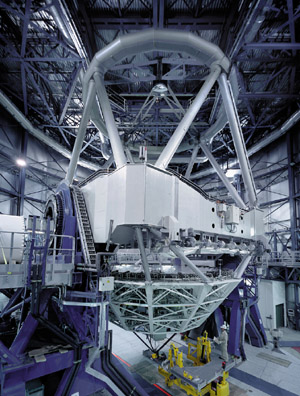Observations at Europe’s Very Large Telescope (VLT) are off to a successful start.
At the
end of May,
the
first astronomical images were taken using the
8.2 m telescope.
A second telescope will be installed this autumn.

The European Southern Observatory’s VLT at Cerro Paranal in the
Chilean Atacama desert should be complete in 2005.
Its four 8.2 m telescopes and
three 1.8 m telescopes will make up the
most sensitive interferometer in the
world.
The first telescope has already achieved a resolution equivalent to resolving a car’s headlights at a distance of 1200 km. Current telescopes can look back around 94% of the lifetime of the universe (assuming a flat universe). With the VLT,
astronomers estimate they will be able to see another 3% further back and are anticipating seeing their first pictures of remote galaxies.
“A key issue is when the dark ages ended,
when the first stars and galaxies started to shine,
” says Cambridge astronomer Sir Martin Rees. He believes if this happened at a redshift of 10,
the VLT will see them. The furthest galaxy observed so far has a redshift of 6.
Sir Martin also anticipates direct observations of planetary systems around other stars. “The telescope’s large collecting area coupled with its high resolution is ideal,
” he says. “Planets are very faint and less than an arcsecond from the star.”
The telescope’s 50 m2 mirror has a surface which is accurate to 5 x 108 m,
equivalent to a 1 mm deviation over an area the size of Paris. The surface is continually corrected for the gravitational distortions caused by the telescope’s support structure.
A system of adaptive optics will be installed in 2000 to correct observations for atmospheric turbulence. A single star will be imaged 100 times a second to measure how its image changes. This data will be used to deform one of the telescope’s mirrors,
reducing observational errors and improving image quality.








